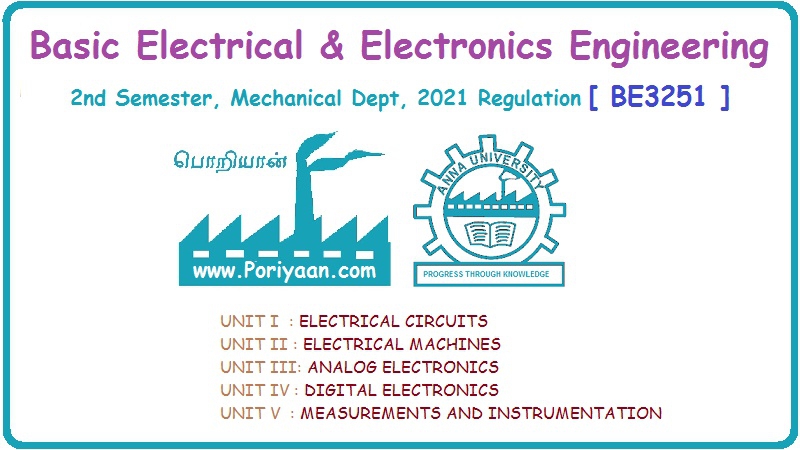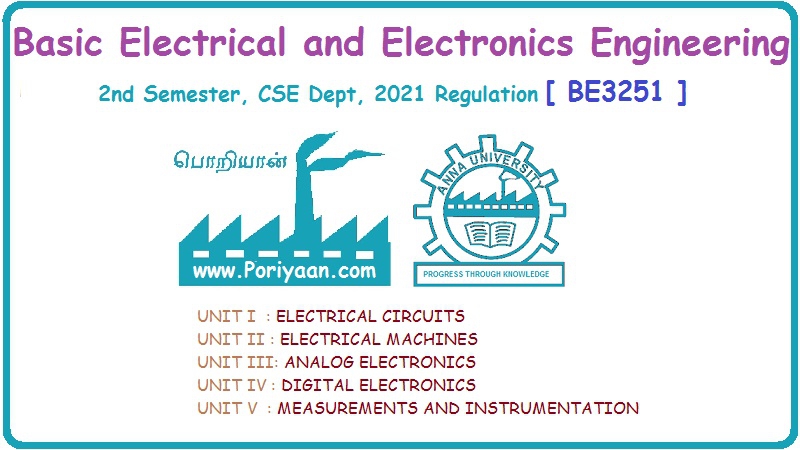Basic Electrical and Electronics Engineering: Unit V: Measurements and Instrumentation
2 Marks Question & Answers
Measurements and Instrumentation | Basic Electrical and Electronics Engineering
2 Marks Question & Answers: Measurements and Instrumentation - Basic Electrical and Electronics Engineering
2 MARKS QUESTION & ANSWERS 1. What are measurements? The measurement of a given quantity is essentially an act or the result of comparison between the quantity (whose magnitude is unknown) & a predefined standard. Since two quantities are compared, the result is expressed in numerical values. 2. What are the advantages of electronic measurement? The advantages of an electronic measurement are 1. Most of the quantities can be converted by transducers into the electrical or electronic signals. 2. An electrical or electronic signal can be amplified, filtered, multiplexed, sampled and measured. 3. The measurement can easily be obtained in or converted into digital form for automatic analysis and recording. 4. The measured signals can be transmitted over long distances with the help of cables or radio links, without any loss of information. 5. Electronic circuits can detect and amplify very weak signals and can measure the events of very short duration as well. 6. Higher sensitivity, low power consumption and a higher degree of reliability are the important features of electronic instruments and measurements. 3. What are the functional elements of an instrument? Most of the measurement systems contain three main functional elements. They are: (i) Primary sensing element (ii) Variable conversion element (iii) Data presentation element. 4. What is meant by calibration? Calibration is the process of making an adjustment or marking a scale so that the readings of an instrument agree with the accepted & the certified standard. 5. What are the types of calibration methodologies? Types of calibration methodologies: There are two methodologies for obtaining the comparison between test instrument and standard instrument. These methodologies are (i) Direct comparisons (ii) Indirect comparisons 6. What are the different size of standards of measurement? The different size of standards of measurement are classified as (i) International standards (ii) Primary standards (iii) Secondary standards (iv) Working standards 7. What are the types of measuring instruments? 1. Absolute Instruments Absolute instruments give the quantity to be measured interms of an instrument constant and its deflection (e.g.,) tangent galvanometer. It gives the value of current interms of the tangent of deflection produced by the current, the radius, the number of turns of wire used and the horizontal component of earths field. 2. Secondary Instruments The value of electrical quantity to be measured can be determined from the deflection of the instruments only when they have been pre-calibrated by comparison with an absolute instrument. The principle of working of all electrical measuring instruments depends on the various effects [magnetic, heating, chemical, electromagnetic thermal and electrostatic] of electric current or voltage. These can be classified as follows. 1. Indicating instruments 2. Recording instruments 3. Integrating instruments 8. What are deflecting torque, controlling torque, damping torque? The deflecting torque is produced by utilizing the various effects (magnetic effect, induction effect, thermal effect, hall effect) of electric current or voltage, and causes the moving system to move and hence the pointer to move from zero position. The controlling torque is produced by spring or gravity and opposes the deflecting torque. The pointer comes to rest at a position, where these two opposing torques are equal. Damping torque is provided by air friction or eddy currents. It ensures that, the pointer comes to the final position, without oscillations, thus enabling accurate and quick readings to be taken. 9. What is the principle of PMMC instruments? PMMC instruments work on the principle that, when a current carrying conductor is placed in a magnetic field, a mechanical force acts on the conductor. The current carrying coil, placed in magnetic field is attached to the moving system. With the movement of the coil, the pointer moves over the scale to indicate the electrical quantity being measured. This type of movement is known as D' Arsonval movement. 10. What is the principle of moving iron instruments? Let a plate or vane of soft iron or of high permeability steel forms the moving element of the system. The iron vane is situated so as, it can move in a magnetic field produced by a stationary coil. The coil is excited by the current or voltage under measurement. When the coil is excited, it becomes an electromagnet and the iron vane moves in such a way so as to increase the flux of the electromagnet. Thus, the vane tries to occupy a position of minimum reluctance. Thus, the force produced is always in such a direction so as to increase the inductance of the coil. 11. What is energy meter? The meter which is used for measuring the energy utilises by the electric load is known as the energy meter. The energy is the total power consumed and utilised by the load at a particular interval of time. It is used in domestic and industrial AC circuit for measuring the power consumption. The meter is less expensive and accurate. 12. What is the use of DSO? The Digital Storage Oscilloscope eliminates the disadvantages of the analog storage oscilloscope. It replaces the unreliable storage method used in analog storage scopes with the digital storage with the help of memory. The memory can store data as long as required without degradation. It also allows the complex processing of the signal by the high speed digital signal processing circuits. 13. What is the data acquisition systems? A typical data acquisition system consists of individual sensors with the necessary signal conditioning, data conversion, data processing, multiplexing, data handling and associated transmission, storage and display systems. Data may be transmitted over long distances or short distances. The data may be displayed on a digital panel or on a CRT.
Basic Electrical and Electronics Engineering: Unit V: Measurements and Instrumentation : Tag: : Measurements and Instrumentation | Basic Electrical and Electronics Engineering - 2 Marks Question & Answers
Related Topics
Related Subjects
Basic Electrical and Electronics Engineering
BE3251 2nd semester Mechanical Dept | 2021 Regulation | 2nd Semester Mechanical Dept 2021 Regulation
Basic Electrical and Electronics Engineering
BE3251 2nd Semester CSE Dept 2021 | Regulation | 2nd Semester CSE Dept 2021 Regulation

